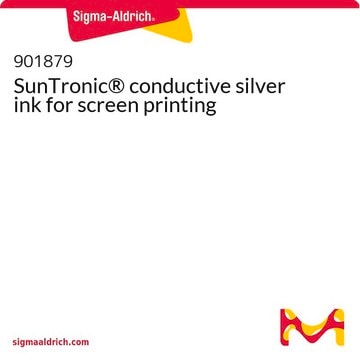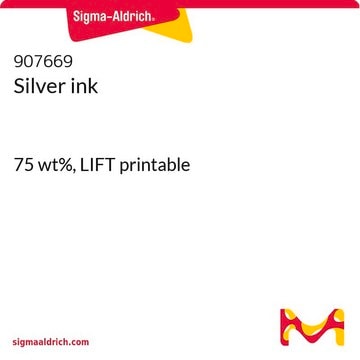There is no specific information available on the exact drying time after printing ink. Overnight drying is generally recommended, but it is important to consider the substrate and environmental conditions, as these can influence the actual drying time. If precise drying time is required, conducting a test on the specific substrate used may provide better guidance.
791873
Conductive silver printing ink, resistivity 5-6 Ω cm
Sinônimo(s):
Greatcell Solar®, Dyesol(R) DYAG50 conductive silver ink, Screen printable silver paste
Selecione um tamanho
Selecione um tamanho
About This Item
Produtos recomendados
descrição
volume resistivity 5 - 6 Ω cm
Nível de qualidade
Ensaio
75-85% solids basis
Formulário
paste (white)
viscosidade
13,000-17,000 mPa.s (at shear rate of 10 sec-1 at 25°C)
Categorias relacionadas
Descrição geral
Aplicação
This Conductive Silver Printing Ink is a specially formulated ink which provides exceptionally high conductivity at low cure temperatures. This highly conductive ink provides extremely low resistance printed conducting tracks, essential for the photovoltaic applications. By providing the lowest track resistances of printed current collectors, this material is a key enabler in plastic electronics, such as, DSSC, OPV, and CdTe solar cells.
Informações legais
GreatcellSolar is a registered trademark of Greatcell Solar Materials Pty Ltd.
Palavra indicadora
Warning
Frases de perigo
Declarações de precaução
Classificações de perigo
Aquatic Acute 1 - Aquatic Chronic 1 - Eye Irrit. 2 - Skin Irrit. 2
Código de classe de armazenamento
10 - Combustible liquids
Classe de risco de água (WGK)
WGK 3
Ponto de fulgor (°F)
174.2 °F
Ponto de fulgor (°C)
79 °C
Escolha uma das versões mais recentes:
Já possui este produto?
Encontre a documentação dos produtos que você adquiriu recentemente na biblioteca de documentos.
Os clientes também visualizaram
Artigos
The ability to pattern conductive electrodes is technologically relevant for several applications, including photovolatics, displays, sensors, and biomedical devices.
Small molecular weight organic semiconductors are promising for flexible transistor applications in next-gen soft electronics.
Dye-sensitized solar cells (DSCs) are 3rd generation solar cells combining the promise of high efficiency with low production costs.
Professors Tokito and Takeda share design principles and optimization protocols for organic electronic devices, focusing on flexibility and low cost.
-
How long does it take to dry naturally after printing ink?
1 answer-
Helpful?
-
-
What is the particle size distribution of the colloidal silver in this ink? What would be the best solvent to use to remove the residual ink from a screen printing mesh?
1 answer-
This item is a product of Greatcell Solar Materials. The manufacturer considers the particle size distribution to be proprietary. The preferred solvent for the removal of residual ink is ethanol. However, the end-user should ensure that the screen material is compatible with the ethanol and ink components before use. The ink components can be found in the product Safety Data Sheet.
Helpful?
-
Active Filters
Nossa equipe de cientistas tem experiência em todas as áreas de pesquisa, incluindo Life Sciences, ciência de materiais, síntese química, cromatografia, química analítica e muitas outras.
Entre em contato com a assistência técnica












